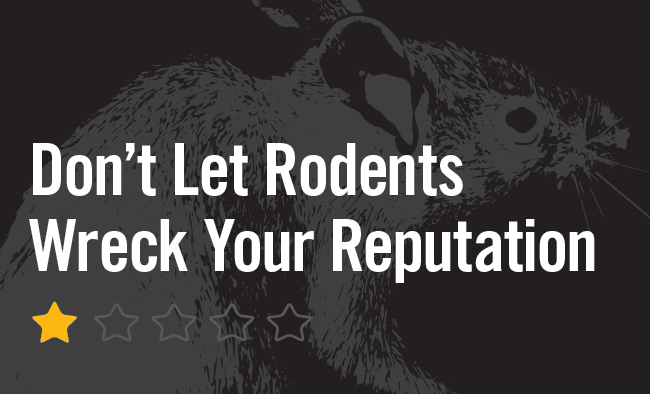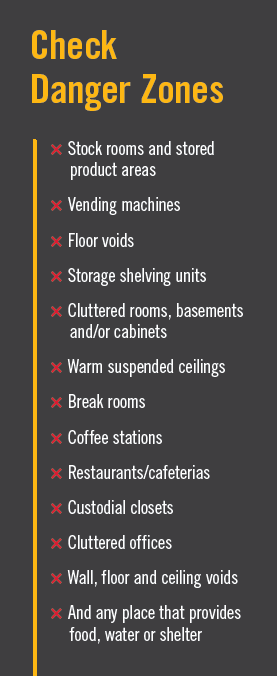At any given time, a pest is looking for food, water and shelter. Warehouses provide these year-round, meaning there’s a constant battle to maintain health and safety. If your facility is lacking in sanitation, then you may find yourself with issues in the long run, whether with the Food and Drug Administration, third-party food safety auditors or customers.
One of the biggest pest threats to your warehouse facility is rodents. They may be small, but don’t underestimate the bite rodents can take out of your business. Rodent control is a $337 million industry for a reason – these pests are widespread, master infiltrators who chomp through wires, contaminate products and spread unsightly diseases. And here’s the dirty truth: your business has everything rats and mice need, and when they move in, they bring some very nasty stuff along.

According to the Centers for Disease Control and Prevention, rodents are known to directly and indirectly transmit 35 different diseases, many of which are potentially lethal. Leptospirosis, salmonellosis and typhus can all be caused by rodents.
With more than 2,000 species scurrying across our planet, rodents make up about 40 percent of all mammals worldwide. And they really get around – a full 20 percent of the world’s food is believed to be contaminated by rats and mice, while one in four structural fires are thought to be caused by rat damage to electrical wires. If your business has a gnawing problem, you’re not alone — rodents are responsible for billions of dollars’ worth of damage each year.
So how do you protect your business from the real risks of rodent infestation, especially in an increasingly strict regulatory environment?
You’ll need to keep a sharp eye on your building’s danger zones and establish a maintenance routine that stops these destructive, disease-carrying pests in their tracks. Let’s start with how to spot rodent activity.
If you detect any of these “tell-tail” signs, alert your pest control provider as soon as possible to begin remediation.
- Keep your eyes peeled for capsule-like pellets. Rats do their business about 30 times per day while mice leave 50-70 droppings per day.
- Grease marks, from oil and dirt on rodents’ bodies are left along their runways, which includes walls and cracks.
- Rats and mice use nests as both their shelters and food storage units.
- Check for chew marks on packages, walls, insulation, wires, flooring and pallets.
- While some rodents prefer the roof, others like to stay close to the ground, burrowing beneath buildings, walls and fences.
With the constant flow of people coming and going, miles of wire to chew on and easy food sources, there are many ways you may be opening the door to rats and mice. Here are five steps to help rat-proof your warehouse.
- Inspection
- Start with the Danger Zones, paying attention to hard-to-reach areas and spaces that may contain traces of food.
- Look out for signs of rodents including droppings and grease marks.

- Exclusion
- Rats can sneak into ½” sized holes, and mice can squeeze through openings as small as ¼” in diameter, so it’s essential to seal off any and all entry points.
- Install door sweeps, seal cracks and eliminate gaps around utility lines and boxes. Trim back vegetation that could touch the roof, cover exterior drains and vents with metal mesh, and install plastic, one-way rodent-proofing valves inside all drains.
- Clean Out
- Cluttered storage areas are a favorite for mice and rats, who source nearby supplies for food and nesting material. Be sure to clean out interior and exterior spaces frequently and have your employees do the same.
- Sanitation
- Rats need food and water to survive, and standing water and scraps in garbage bins are on their menu. Continuously empty common area garbage bins, clean out dumpsters, and check outside faucets and gutters for leaks and/or puddles.
- Monitoring
- Consistent monitoring and maintenance of your property’s unique problems are essential to identifying problems early. Keep the lines of communication open between your staff, maintenance crew and pest management provider.
Now you know your enemy and the nooks, crannies, crevices and burrows they like to hide in. You’ve also learned the unfortunate, foul signs that they may be in your midst. If you’ve spotted any of their leave-behinds, it’s time to contact a pest control expert to do the dirty work for you. Western Pest Services offers thorough rodent control year-round. Using Integrated Pest Management (IPM), we not only get rid of rodents – we help you close the door on pests for good.